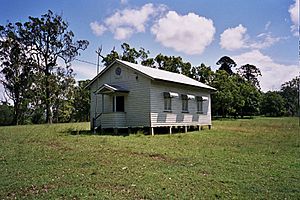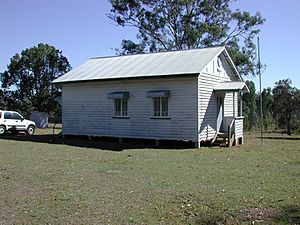Wonglepong QCWA Hall facts for kids
Quick facts for kids Wonglepong QCWA Hall |
|
|---|---|

Wonglepong QCWA Hall, 2006
|
|
| Location | 2779 Beaudesert-Nerang Road, Wonglepong, Scenic Rim Region, Queensland, Australia |
| Design period | 1919 - 1930s (interwar period) |
| Built | 1935 |
| Official name: Wonglepong QCWA Hall | |
| Type | state heritage (built) |
| Designated | 11 November 2005 |
| Reference no. | 602549 |
| Significant period | 1935 (fabric) 1935-ongoing (social) |
| Significant components | tank stand, furniture/fittings, objects (movable) - social/community |
| Builders | EJ Franklin |
| Lua error in Module:Location_map at line 420: attempt to index field 'wikibase' (a nil value). | |
The Wonglepong QCWA Hall is a special old building in Wonglepong, Queensland, Australia. It's a community hall that was built in 1935 by EJ Franklin. This hall is so important that it's listed on the Queensland Heritage Register. This means it's protected because of its history and value.
The hall is a small, one-room building made of timber. It sits in a rural area of Wonglepong, north of Canungra. The hall was built especially for the Wonglepong branch of the Queensland Country Women's Association (QCWA). This group still uses the hall today, and it looks much like it did when it was first built.
Contents
What is the QCWA?
The Queensland Country Women's Association (QCWA) is a group that helps women and children in rural areas. It was started in August 1922 in Brisbane. At that time, Queensland was facing a big drought. The group wanted to help country women with the problems they were having.
The QCWA's goal was to make life better for women and children in the countryside. They wanted to give them chances to meet people and have fun. They also worked to improve education and health in rural areas. The Governor of Queensland, Sir Matthew Nathan, even supported the group and became its patron.
How the QCWA Helped Communities
The QCWA quickly became a very important part of country towns. New branches opened in places like Kingaroy and Warwick just a few months after the group started.
The QCWA helped families in many practical ways. They provided places for holidays by the beach and rest rooms for mothers. They also set up bush nurse centers and hostels for students. They worked to help rural women learn new skills. They held lectures, taught handicrafts, and kept libraries in their halls. The QCWA also talked to the government about issues important to country people. Their halls often became central places for local communities. The QCWA was one of the most important women's groups in Australia during the 20th century.
History of Wonglepong Hall
The Wonglepong branch of the QCWA started in 1925. At that time, the Beaudesert Shire area was busy with farmers and timber workers. From the early 1900s to the 1930s, the area grew quickly. This was thanks to dairy farming, cattle grazing, and the timber industry.
The Wonglepong QCWA branch was one of the first in the Upper Logan and Albert Rivers area. For the first eight years, they met at the home of their first president, Ann Franklin. By the 1930s, Ann's health made it hard for her to host. Members then took turns holding meetings in their own homes.
Building the Hall
However, getting to meetings was difficult for many members. Also, more people had joined the group. So, the members decided to build their own hall. They started saving money, and by 1935, they had £58.
The hall was built on land that the Franklin family leased to the QCWA branch for 99 years. The timber for the hall likely came from the Franklin family's own property. It was cut at Geo Franklin's mill in Canungra. E. J. Franklin, Ann's son, was the main builder. The husbands of the members helped him for free.
The hall officially opened on 4 December 1935. Mrs Buchanan, a president from the QCWA's Central Division, opened it. The branch also started a library in the hall that same year. In 1937, the inside of the hall was lined with timber. A special cabinet for the library was also built using matching timber from the property.
Hall Furnishings and Changes
Members of the QCWA donated the furniture for the hall. This included several pews (long benches) that E. J. Franklin made for the group. The original design for these pews is still kept in the hall. The President's chair was given by a Franklin family member to remember his mother, Jane. The QCWA creed and motto were painted by Frank Tunley. He was the brother of the first Secretary, A. G. Campbell.
The hall still looks very much like it did when it was built. The library cabinet and the timber lining inside have never been painted. The cabinet still holds many books from when the library first started.
Only a few big changes have been made to the hall. A kitchen was added in 1965. The hall's supports were also replaced that year. The outside of the hall was painted in 1975, and the roof was replaced in 1983. The Wonglepong branch has kept all its meeting notes since it began. This is rare, as few QCWA branches have kept records for so long.
From the late 1900s, the Wonglepong area started to change. It went from being mostly farms to having more rural homes. Since the 1960s, fewer people have joined the QCWA across Queensland. However, the Wonglepong branch is still active. It is one of the few QCWA branches still working in the Scenic Rim Region.
What the Hall Looks Like
The QCWA hall is in a grassy field. It is about 35 meters back from the Beaudesert - Nerang Road in Wonglepong. It sits on a small piece of land within a larger farm.
The hall is shaped like a rectangle. It is about nine meters long and six meters wide. There are not many fancy decorations. The main decoration is the QCWA symbol above the entrance on the gable (the triangular part of the wall under the roof).
The building has a timber frame and is covered with weatherboards. You enter the building through a small porch and a set of double doors. Each door has a square frosted glass window near the top. The roof is made of unpainted corrugated iron and has a pointed shape. The original timber supports under the hall have been replaced with concrete ones.
The entrance porch is in the middle of the eastern side of the building. You get to the porch by a small set of steps on the southeast side. The sides of the porch are partly covered with weatherboards. About two-thirds of each side are open to the roof.
All the windows are casement windows that open from the center. Each window is divided into five sections. There is a large rectangle in the middle with two small square sections at the top and bottom. Three windows are on the northwest side and two on the southeast side. Each window has a curved metal cover above it.
You can also enter the hall from the back. There is a wooden door at the southwest end of the back wall. A metal awning sticks out above this door. Steps lead up to the door. A corrugated iron water tank with a timber stand is near the middle of the back wall.
Inside the Hall
The inside of the hall is one large room. It has a shiny timber floor and the walls are lined with unpainted hardwood. The library cabinet is built into the wall to the right of the main entrance. It is made from vertical hardwood boards that match the walls. Two hinged doors, also made of vertical hardwood boards, open to the inside of the cabinet.
The hall has several tables, four wooden pews, a bench, and an upright piano. Pictures and printed items are hung on the walls. These include the QCWA creed and motto, and a memorial from World War I.
The kitchen cupboards were built in 1965. They are against the wall opposite the main entrance. These cupboards are not part of the heritage listing.
Why the Hall is Important
The Wonglepong QCWA Hall was added to the Queensland Heritage Register on 11 November 2005. It meets several important standards to be listed.
Demonstrating Queensland's History
The Wonglepong QCWA Hall shows an important part of Queensland's history. The QCWA was one of the most important women's groups in the 20th century. It was formed because country women faced many difficulties and felt isolated. The group was, and still is, a key part of rural communities in Queensland.
The Wonglepong branch is a good example of a small country QCWA branch. Its history is very well recorded in Queensland. It has kept its meeting notes since it started in 1925. This was just three years after the QCWA itself was founded. The hall is also very well preserved and looks much the same as when it was built in 1935.
Showing Key Features of QCWA Halls
This building shows the main features of a small QCWA hall from the first half of the 20th century. It is in a rural area, set back from the road on a small farm. The QCWA symbol is clearly displayed above the entrance. Inside, the QCWA creed and motto are hung on the walls, along with a World War I honor roll. The small library in the hall is also a common feature. Many QCWA branches had libraries to help educate their members.
Special Connection to the Community
The hall has a special connection with the local QCWA members. The branch is also well known within the QCWA across Queensland. The land for the hall was leased to the QCWA by the first president. Her son oversaw the building of the hall, and members' husbands helped him for free. Members donated the hall's furniture, including the pews made by the first president's son. The brother of the first secretary painted the creed and motto.


